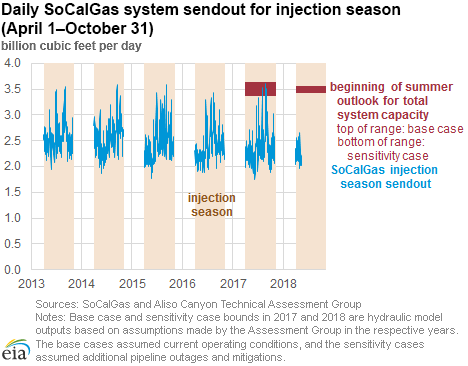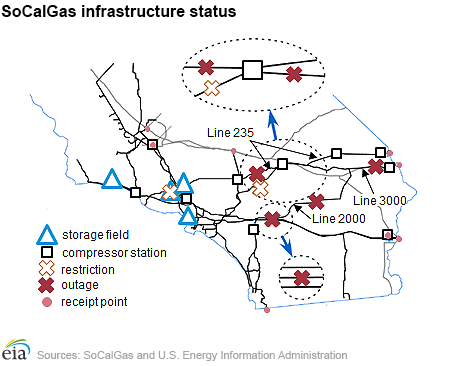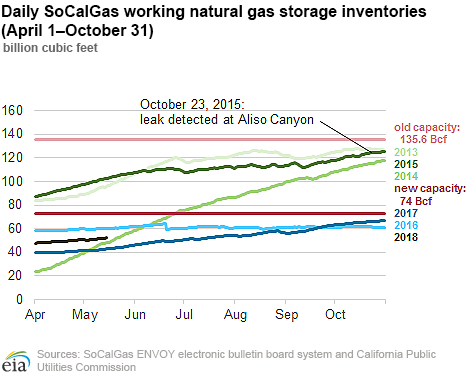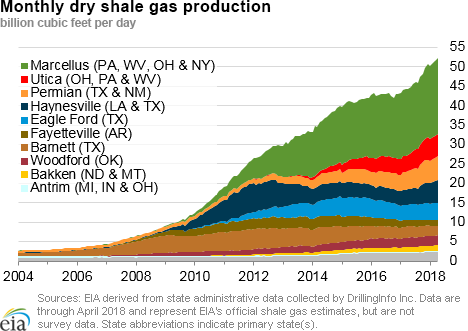Updated on May 18, 2018 to correct the storage capacity.
In the News:
Reduced natural gas infrastructure capacity may pose summer energy reliability challenges in Southern California
Separate studies released during the past few weeks by the Southern California Gas Company (SoCalGas) and Aliso Canyon Technical Assessment Group (the Assessment Group), which includes the California Public Utility Commission, the California Energy Commission, the California Independent System Operator, and the Los Angeles Department of Water and Power, highlight potential electricity reliability concerns for the upcoming summer that have implications for the upcoming winter. Presented on May 7, these concerns mostly stem from limited availability of natural gas pipeline receipt capacity and continuing restrictions affecting SoCalGas storage operations.
The Assessment Group concluded that base case total system deliverability capacity—a combination of both natural gas pipeline system and non-Aliso storage working gas deliverability capacity—is a little less than 3.6 Bcf/d this summer, or 200 million cubic feet per day (MMcf/d) lower than last summer. If natural gas demand exceeded 3.6 Bcf/d—which occurred only once between 2013 and 2017, on August 28, 2017—it might require curtailing natural gas deliveries to electric generators.
Since October 2017, SoCalGas has experienced a series of planned and unplanned natural gas pipeline outages that have reduced the ability to bring natural gas into Southern California. According to the May 7, 2018 SoCalGas maintenance schedule, pipeline repairs are not expected to be completed until the end of summer, with key pipelines—Lines 4000, 235-2, and 2000—showing no estimated end date for work to be completed. Pipeline receipt capacity for summer 2018 is down about 530 MMcf/d from summer 2017.
Natural gas inventories in Southern California are also typically refilled over the course of the summer months. However, this period also corresponds with peak electricity demand for cooling, and natural gas is a key fuel source for electric power generation in Southern California. According to SoCalGas, the current outages will create challenges this summer for meeting customer demand while also refilling storage inventories. SoCalGas’s ability to refill storage will depend on temperatures this summer. Currently, the National Oceanic and Atmospheric Administration (NOAA) forecasts a warmer-than-normal summer (June/July/August) in Southern California.
The profile of refilling natural gas at SoCalGas’ storage fields has changed since a leak at Aliso Canyon storage complex was discovered in October 2015. After the Aliso Canyon well failure, the total capacity of the four storage facilities in the SoCalGas service territory has declined to 74 Bcf (of which Aliso Canyon has capacity of 24.6 Bcf) from 135.6 Bcf previously. Working gas inventories as of May 14, 2018, totaled 51.5 Bcf, which is low by historical standards, but 9.5 Bcf higher than at this time in 2017 and 8 Bcf lower than at this time in 2016.
The Assessment Group’s report issued a series of recommendations to help Southern California address reliability challenges, including: importing liquefied natural gas (LNG) through the Otay Mesa receipt point at the San Diego–Mexico border, improving compliance with operational flow orders, expediting any pending electricity transmission upgrades, taking advantage of demand response pilot projects, and exploring an increase in the maximum target inventory at Aliso Canyon.
EIA provides a daily summary of key energy conditions in Southern California on the Southern California Daily Energy Report. In addition to the daily summary, EIA provides occasional commentary and analysis on notable market conditions in Southern California.
Overview:
(For the Week Ending Wednesday, May 16, 2018)
- Natural gas spot prices rose at most locations this report week (Wednesday, May 9 to Wednesday, May 16). The Henry Hub spot price rose from $2.72 per million British thermal units (MMBtu) last Wednesday to $2.78/MMBtu yesterday.
- At the New York Mercantile Exchange (Nymex), the June 2018 contract price rose 8¢ from $2.737/MMBtu last Wednesday to $2.815/MMBtu yesterday.
- Net injections to working gas totaled 106 billion cubic feet (Bcf) for the week ending May 11. Working natural gas stocks are 1,538 Bcf, which is 35% lower than the year-ago level and 25% lower than the five-year (2013–17) average for this week.
- The natural gas plant liquids composite price at Mont Belvieu, Texas, rose by 25¢, averaging $8.24/MMBtu for the week ending May 16. The price of ethane fell by 3%, while the prices of natural gasoline, propane, butane, and isobutane rose by 1%, 2%, 4%, and 18%, respectively.
- According to Baker Hughes, for the week ending Tuesday, May 8, the natural gas rig count increased by 3 to 199. The number of oil-directed rigs rose by 10 to 844. The total rig count increased by 13, and it now stands at 1,045.
Prices/Supply/Demand:
Henry Hub prices rise with warmer weather across the southern United States. This report week (Wednesday, May 9 to Wednesday, May 16), the Henry Hub spot price rose 6¢ from $2.72/MMBtu last Wednesday to $2.78/MMBtu yesterday, the prices for delivery on last Thursday and today, respectively. Average temperatures across most of the southern United States are generally expected to be warmer today than last Thursday, ranging from 5°F (degrees Fahrenheit)–20°F higher today than last Thursday. Average temperatures for the week are expected to reach more than 75°F in parts of Texas and in the Southeast.
Prices at key Midwest trading hub increase Wednesday over Wednesday. At the Chicago Citygate, prices increased 7¢ from $2.41/MMBtu last Wednesday to $2.48/MMBtu yesterday. Despite the expectation of cooler temperatures today compared to last Thursday, most of the lower Midwest—including southern Illinois—are expected to have warmer average temperatures this report week compared with last report week, according to data from NOAA.
California prices are mixed. Prices at PG&E Citygate in Northern California rose 13¢, up from $2.77/MMBtu last Wednesday to $2.90/MMBtu yesterday. PG&E—the operator of the primary natural gas distribution system in Northern California—also announced pipeline maintenance activity that is expected to reduce overall pipeline capacity on the distribution system through the end of May.
The price at SoCal Citygate decreased 9¢ from $3.12/MMBtu last Wednesday to $3.03/MMBtu yesterday. Despite ongoing natural gas pipeline and storage limitations, which have reduced SoCalGas’s flexibility to meet natural gas demand (see In the News for this report week), overall natural gas consumption in Southern California for this report week decreased with moderate temperatures in coastal Southern California.
Prices in New England rise amid ongoing capacity constraints. At the Algonquin Citygate, which serves Boston-area consumers, prices went up 13¢ from $2.27/MMBtu last Wednesday to $2.40/MMBtu yesterday. According to Algonquin Gas Transmission’s electronic bulletin board, a series of maintenance activities has decreased pipeline capacity in New England. In addition, natural gas deliveries from the Millennium pipeline to the Algonquin Gas Transmission pipeline system—a key pipeline for bringing natural gas into New England—fell sharply during this report week as the Millennium pipeline began maintenance and eastbound flow capacity was reduced from about 1 Bcf/d to 0.3 Bcf/d.
At the Transcontinental Pipeline Zone 6 trading point for New York City, prices decreased 37¢ from $2.69/MMBtu last Wednesday to $2.32/MMBtu yesterday.
Appalachian spot prices trade $0.60 to $2.00 lower than Henry Hub. Tennessee Zone 4 Marcellus spot prices decreased 95¢ from $1.72/MMBtu last Wednesday to $0.77/MMBtu yesterday. Prices at Dominion South in northwest Pennsylvania rose 8¢ from $2.11/MMBtu last Wednesday to $2.19/MMBtu yesterday.
Overall supply is flat week over week. According to data from PointLogic Energy, the average total supply of natural gas remained the same as in the previous report week, averaging 85.6 Bcf/d. Dry natural gas production decreased by 1% compared with the previous report week, largely because of Northeast production declines associated with takeaway capacity reductions from the Millennium pipeline maintenance. Average net imports from Canada increased by 1% from last week.
Demand increases week over week as electric power sector consumption rises. Total U.S. consumption of natural gas rose by 4% compared with the previous report week, according to data from PointLogic Energy. Natural gas consumed for power generation climbed by 8% week over week as average temperatures for the week rose higher than 75°F in parts Texas and the Southeast. Industrial sector consumption stayed constant, averaging 19.9 Bcf/d. In the residential and commercial sectors, consumption increased by 3% with much of the West and Northeast cooler this report week compared with last report week. Natural gas exports to Mexico were the same as last week, averaging 4.4 Bcf/d.
U.S. liquefied natural gas (LNG) exports increase week over week. Seven LNG vessels (combined LNG-carrying capacity 25.8 Bcf) departed the United States from May 10 to May 16 (six tankers from Sabine Pass liquefaction terminal and one tanker from Cove Point).
The first U.S. LNG cargo to Israel is en route to Hadera Gateway regasification terminal and is carried on LNG tanker British Diamond, scheduled to arrive in Israel on May 27, according to the shipping data compiled by Bloomberg.
Storage:
Net injections top the 100 Bcf threshold in May for the first time since 2015. Net injections into storage totaled 106 Bcf for the week ending May 11, compared with the five-year (2013–17) average net injection of 87 Bcf and last year's net injections of 64 Bcf during the same week. This report week had the largest reported May weekly net injection since May 29, 2015, when net injection reached its record high of 132 Bcf. Net injections during the week averaged 15.1 Bcf/day; net injections will have to average 13.1 Bcf/day for the remainder of the refill season to match the five-year average level (3,806 Bcf) by October 31. Working gas stocks totaled 1,538 Bcf, which is 501 Bcf lower than the five-year average and 821 Bcf lower than last year at this time.
Despite low storage inventories, the average January 2019 futures contract price trades at a smaller premium to the average spot price than last year at this time. During the most recent storage week, the average natural gas spot price at the Henry Hub averaged $2.71/MMBtu, and the Nymex futures price of natural gas for delivery in January 2019 averaged $3.00/MMBtu, 29¢/MMBtu higher than the spot price. A year ago, the January contract was 54¢/MMBtu higher than the spot price. These pricing patterns reflect the relative economics supporting injections into working gas storage.
Reported net injection into storage is close to the median of analysts’ expections. According to the Desk survey of natural gas analysts, estimates of the weekly net change from working natural gas storage ranged from net injections of 99 Bcf to 110 Bcf, with a median estimate of 104 Bcf. At the 10:30 a.m. release of the Weekly Natural Gas Storage Report (WNGSR), 299 trades were executed, decreasing the Nymex price for June delivery less than 1¢/MMBtu to $2.79/MMBtu. Several seconds after the release, trading activity increased with 1,075 trades during a one-second span as prices recovered, averaging $2.80/MMBtu.
Temperatures are in the normal range for the storage week. Temperatures in the Lower 48 states averaged 64 °F, 4°F higher than normal and 6°F higher than last year at this time. Tempertures were 6°F warmer on average than the previous report week.
See also:
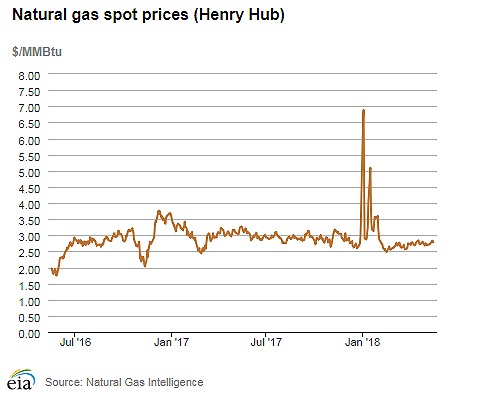
| Spot Prices ($/MMBtu) | Thu, 10-May |
Fri, 11-May |
Mon, 14-May |
Tue, 15-May |
Wed, 16-May |
|---|---|---|---|---|---|
| Henry Hub |
2.73 |
2.75 |
2.83 |
2.83 |
2.78 |
| New York |
2.46 |
2.50 |
2.41 |
2.49 |
2.32 |
| Chicago |
2.43 |
2.37 |
2.54 |
2.61 |
2.48 |
| Cal. Comp. Avg.* |
2.12 |
2.06 |
2.22 |
2.22 |
2.24 |
| Futures ($/MMBtu) | |||||
| June contract | 2.814 |
2.806 |
2.842 |
2.836 |
2.815 |
| July contract |
2.828 |
2.825 |
2.859 |
2.854 |
2.837 |
| *Avg. of NGI's reported prices for: Malin, PG&E Citygate, and Southern California Border Avg. | |||||
| Source: NGI's Daily Gas Price Index | |||||

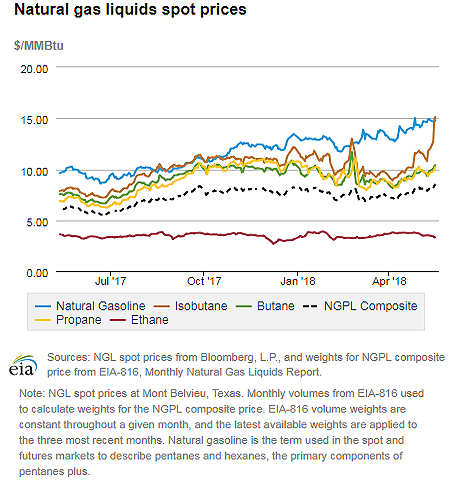
| U.S. natural gas supply - Gas Week: (5/10/18 - 5/16/18) | |||
|---|---|---|---|
Average daily values (Bcf/d): |
|||
this week |
last week |
last year |
|
| Marketed production | 89.8 |
90.1 |
80.1 |
| Dry production | 79.5 |
79.9 |
71.0 |
| Net Canada imports | 6.1 |
6.0 |
5.7 |
| LNG pipeline deliveries | 0.1 |
0.1 |
0.1 |
| Total supply | 85.6 |
85.9 |
76.7 |
|
Source: OPIS PointLogic Energy, an IHS Company | |||
| U.S. natural gas consumption - Gas Week: (5/10/18 - 5/16/18) | |||
|---|---|---|---|
Average daily values (Bcf/d): |
|||
this week |
last week |
last year |
|
| U.S. consumption | 57.5 |
55.3 |
56.8 |
| Power | 28.6 |
26.6 |
23.9 |
| Industrial | 19.9 |
19.9 |
20.1 |
| Residential/commercial | 9.1 |
8.8 |
12.9 |
| Mexico exports | 4.4 |
4.4 |
4.2 |
| Pipeline fuel use/losses | 6.5 |
6.2 |
6.4 |
| LNG pipeline receipts | 3.5 |
3.3 |
2.3 |
| Total demand | 72.0 |
69.2 |
69.7 |
|
Source: OPIS PointLogic Energy, an IHS Company | |||
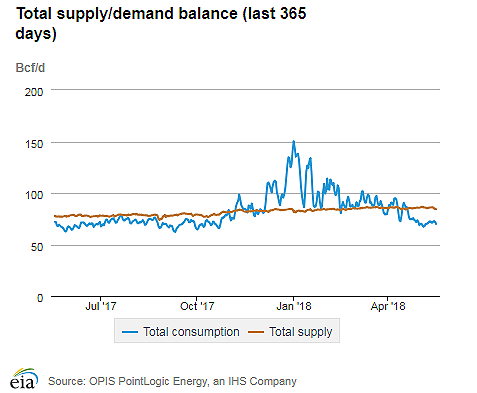
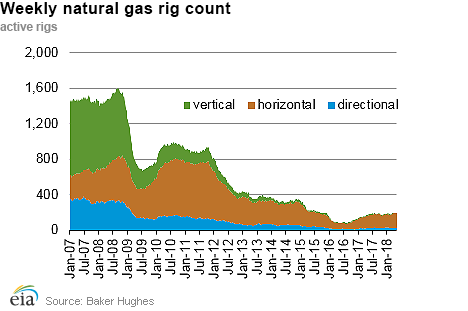
| Rigs | |||
|---|---|---|---|
Tue, May 08, 2018 |
Change from |
||
last week |
last year |
||
| Oil rigs | 844 |
1.2% |
18.5% |
| Natural gas rigs | 199 |
1.5% |
15.7% |
| Note: Excludes any miscellaneous rigs | |||
| Rig numbers by type | |||
|---|---|---|---|
Tue, May 08, 2018 |
Change from |
||
last week |
last year |
||
| Vertical | 55 |
0.0% |
-28.6% |
| Horizontal | 918 |
0.5% |
23.7% |
| Directional | 72 |
12.5% |
9.1% |
| Source: Baker Hughes Inc. | |||
| Working gas in underground storage | ||||
|---|---|---|---|---|
Stocks billion cubic feet (Bcf) |
||||
| Region | 2018-05-11 |
2018-05-04 |
change |
|
| East | 275 |
243 |
32 |
|
| Midwest | 267 |
240 |
27 |
|
| Mountain | 98 |
92 |
6 |
|
| Pacific | 204 |
195 |
9 |
|
| South Central | 694 |
662 |
32 |
|
| Total | 1,538 |
1,432 |
106 |
|
| Source: U.S. Energy Information Administration | ||||
| Working gas in underground storage | |||||
|---|---|---|---|---|---|
Historical comparisons |
|||||
Year ago (5/11/17) |
5-year average (2013-2017) |
||||
| Region | Stocks (Bcf) |
% change |
Stocks (Bcf) |
% change |
|
| East | 365 |
-24.7 |
373 |
-26.3 |
|
| Midwest | 538 |
-50.4 |
421 |
-36.6 |
|
| Mountain | 160 |
-38.8 |
131 |
-25.2 |
|
| Pacific | 243 |
-16.0 |
254 |
-19.7 |
|
| South Central | 1,054 |
-34.2 |
860 |
-19.3 |
|
| Total | 2,359 |
-34.8 |
2,039 |
-24.6 |
|
| Source: U.S. Energy Information Administration | |||||
| Temperature – heating & cooling degree days (week ending May 10) | ||||||||
|---|---|---|---|---|---|---|---|---|
HDD deviation from: |
CDD deviation from: |
|||||||
| Region | HDD Current |
normal |
last year |
CDD Current |
normal |
last year |
||
| New England | 59 |
-22 |
-42 |
0 |
0 |
0 |
||
| Middle Atlantic | 32 |
-34 |
-61 |
4 |
3 |
4 |
||
| E N Central | 42 |
-29 |
-62 |
1 |
-4 |
1 |
||
| W N Central | 42 |
-20 |
-4 |
9 |
2 |
0 |
||
| South Atlantic | 4 |
-23 |
-42 |
48 |
19 |
22 |
||
| E S Central | 9 |
-16 |
-33 |
31 |
11 |
16 |
||
| W S Central | 11 |
4 |
-2 |
34 |
-9 |
0 |
||
| Mountain | 36 |
-38 |
-10 |
26 |
12 |
9 |
||
| Pacific | 8 |
-38 |
-33 |
6 |
0 |
0 |
||
| United States | 26 |
-26 |
-38 |
19 |
4 |
6 |
||
|
Note: HDD = heating degree day; CDD = cooling degree day Source: National Oceanic and Atmospheric Administration | ||||||||
Average temperature (°F)
7-Day Mean ending May 10, 2018
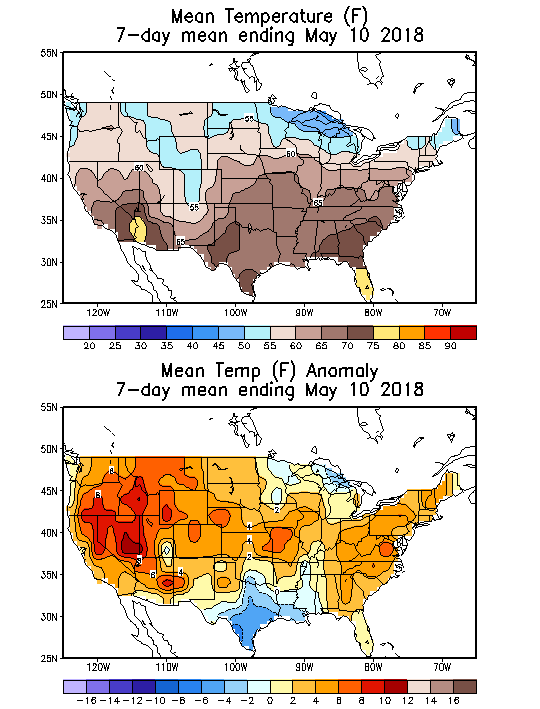
Source: NOAA National Weather Service
Deviation between average and normal (°F)
7-Day Mean ending May 10, 2018

Source: NOAA National Weather Service

